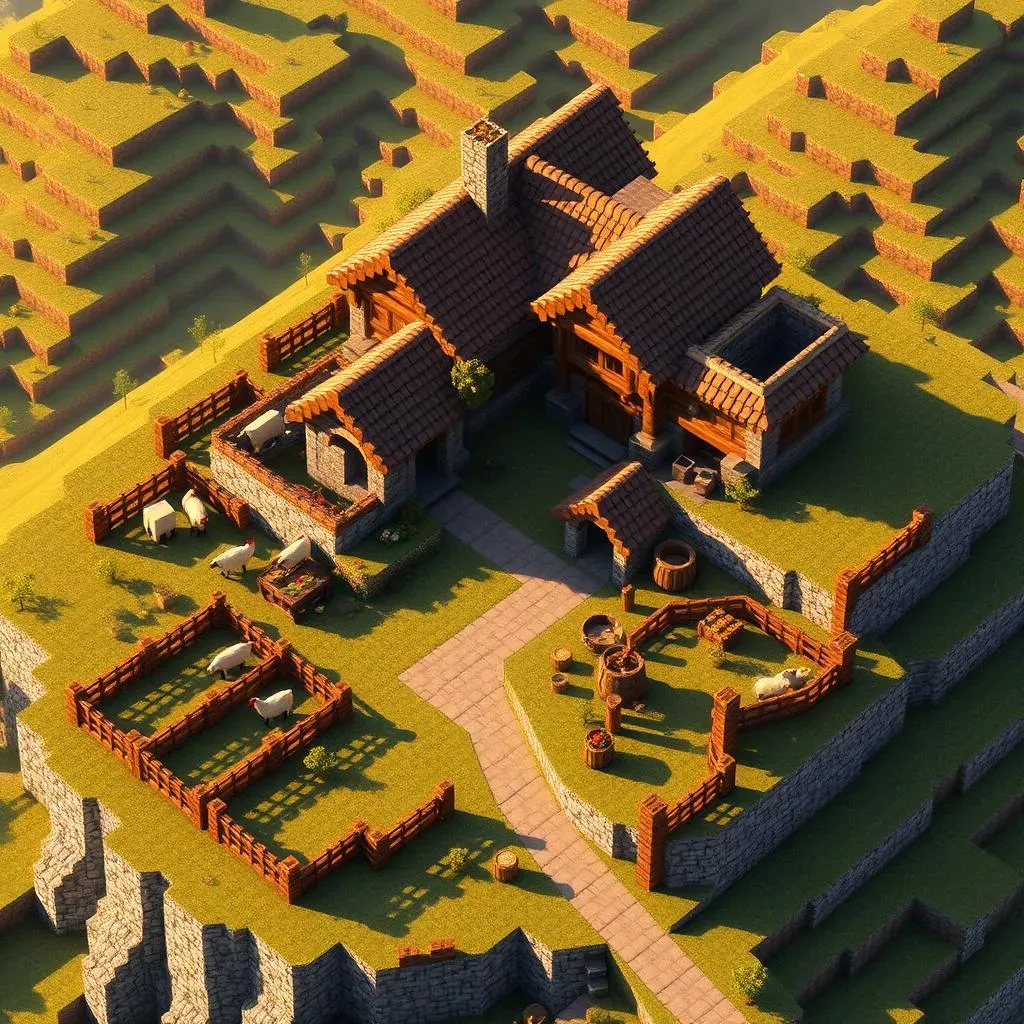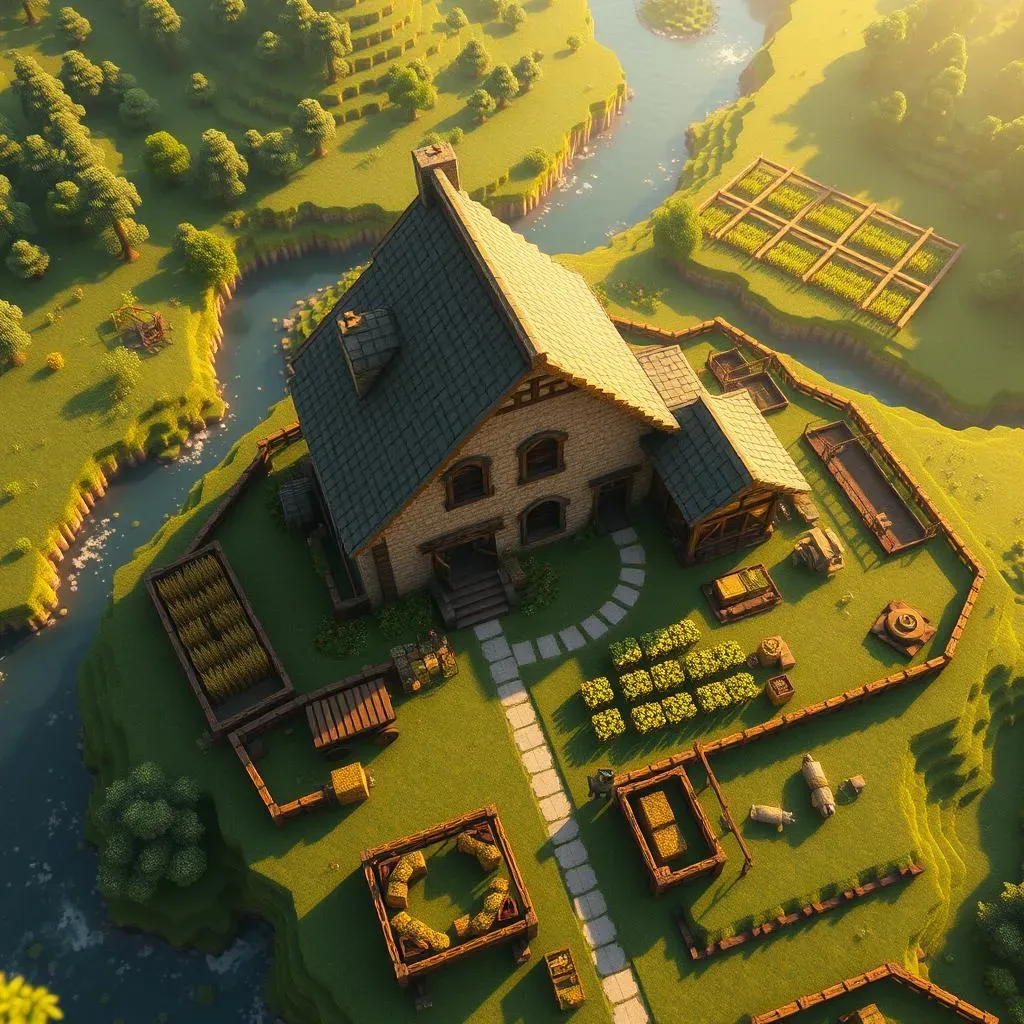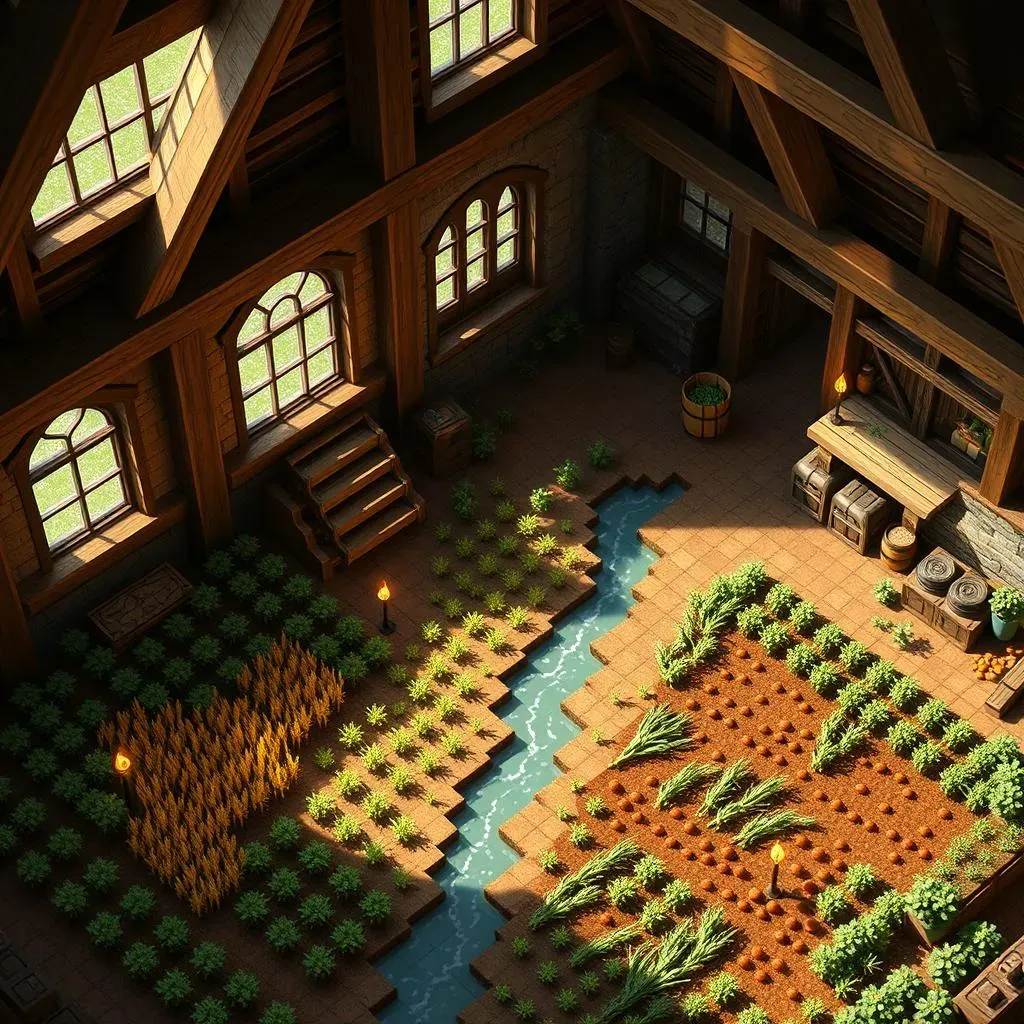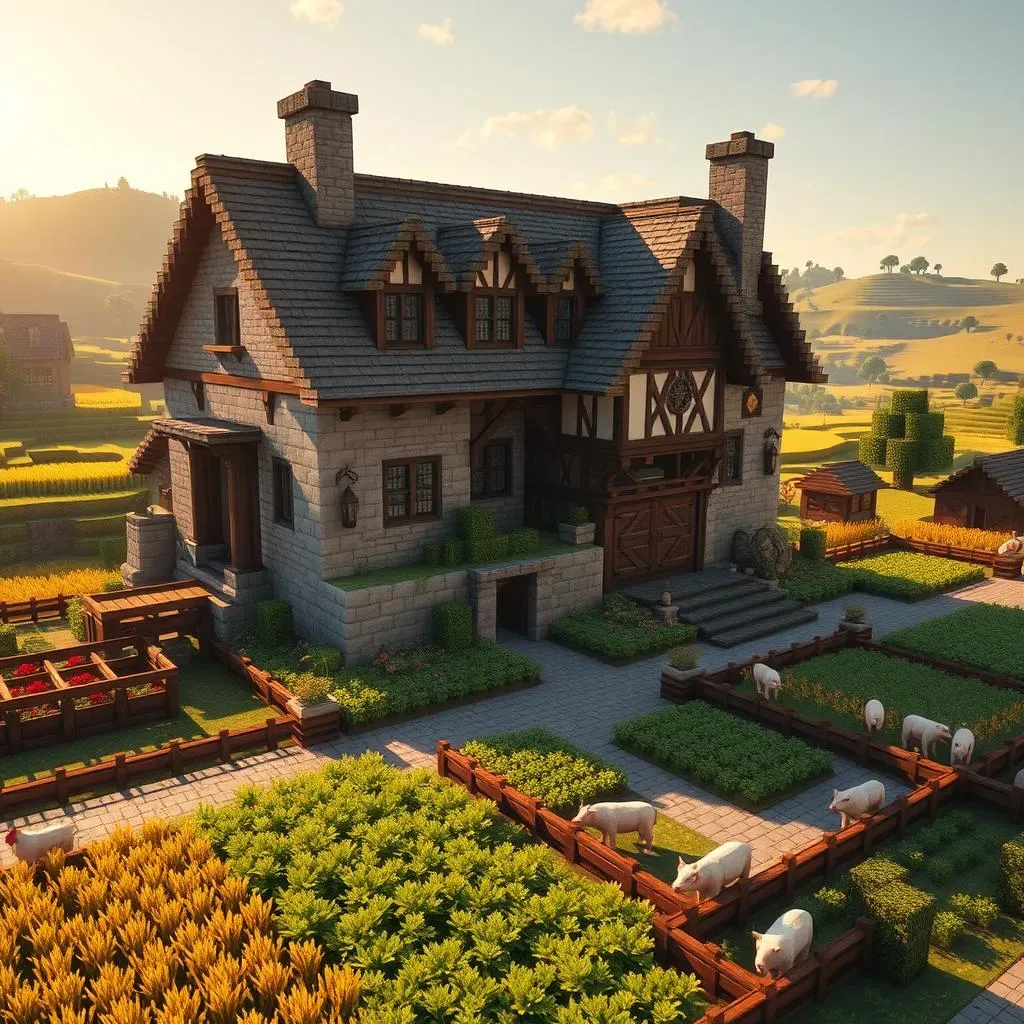Table of Contents
Ever get that itch to build something truly epic in Minecraft? Something that screams both "cozy home" and "productive farm" all at once? If you're nodding your head, then you're probably dreaming of a medieval Minecraft house farm design. It's that perfect blend of rustic charm and practical living, right in your pixelated world. But where do you even start? How do you make it look authentically medieval and actually function as a farm? This isn't just about slapping some cobblestone together and calling it a day. We're talking about crafting a build that feels like it belongs in a medieval village while also churning out crops and resources like a well-oiled machine. In this guide, we'll break down the essential elements of a killer medieval Minecraft house farm design, walk you through a step-by-step building process, spark your imagination with creative ideas, and arm you with pro tips to maximize your farm's efficiency. Ready to trade your dirt shack for a majestic medieval Minecraft house farm? Let's get building!
Essential Elements of a Medieval Minecraft House Farm Design

Essential Elements of a Medieval Minecraft House Farm Design
Choosing the Right Blocks for a Medieval Vibe
So, you're diving into a medieval Minecraft house farm design? Awesome choice! First things first, let's talk blocks. Block choice is absolutely key to nailing that medieval aesthetic. Think natural, earthy tones and textures. Cobblestone is your best friend here – it's rugged, it's classic, it screams medieval. Wood is another must-have. Oak logs, spruce planks, dark oak – mix and match them for walls, roofs, and support beams. Stone bricks are fantastic for adding a touch of class and sturdiness. Avoid overly smooth or modern-looking blocks like quartz or concrete if you're going for true medieval vibes. Remember, we're aiming for that aged, weathered look, like your farmhouse has been standing for centuries, patiently waiting for you to spawn into existence.
Designing a Functional and Beautiful Farm Layout
looks are important, but this is a farm, right? Functionality is just as crucial in your medieval Minecraft house farm design. Think about how you want your farm to actually work. Do you want sprawling fields, neat rows of crops, or maybe a mix of both? Consider incorporating different levels for your farm. Terraced fields on a hillside can look incredibly picturesque and maximize space. Don't forget animal pens! Sheep, cows, chickens – they all need a home that fits the medieval theme. Fences made of wood or cobblestone walls work great. Water sources are vital for crop growth and adding visual appeal. A well, a small pond, or even a simple stream running through your farm can elevate the whole design. Make sure your storage is easily accessible too. Barns, sheds, or even cleverly hidden cellars can keep your medieval farm organized and efficient. Remember, a good farm is a working farm, even in Minecraft!
Block Type | Medieval Vibe | Use Case |
|---|---|---|
Cobblestone | Rugged, Classic | Walls, Foundations, Paths |
Oak Logs & Planks | Warm, Rustic | Walls, Roofs, Framing |
Stone Bricks | Sturdy, Refined | Walls, Detailing, Fireplaces |
Spruce Wood | Dark, Cozy | Roofs, Trim, Furniture |
Integrating House and Farm Seamlessly
Now for the magic touch – blending your house and farm into one harmonious medieval Minecraft house farm design. This is where it goes from just a house next to a farm to a true farmhouse. Think about extending your house outwards to incorporate farm elements. Maybe a stable attached to the side, or a barn connected by a covered walkway. Use the same block palette and architectural style for both the house and the farm buildings to create visual unity. Consider vertical integration too. Could you have a garden on your rooftop? Or a chicken coop built into the upper level of a barn? Details are key here. Hay bales, barrels, lanterns, flower boxes – these little touches bring your medieval Minecraft house farm design to life and make it feel like a genuinely lived-in and loved space. It's all about creating a cohesive and charming build where house and farm become one!
StepbyStep Guide to Building Your Medieval Minecraft Farmhouse

StepbyStep Guide to Building Your Medieval Minecraft Farmhouse
Alright, ready to get your hands dirty (virtually, of course)? Let's dive into the nitty-gritty of actually building your medieval Minecraft farmhouse step-by-step. First up, location, location, location! Find yourself a spot that just feels right. Maybe a nice grassy plain with a forest nearby for wood, or nestled in a valley with a river running through it. Once you've staked your claim, gather your resources. Cobblestone, wood, stone bricks – the usual medieval suspects. Having a good stockpile ready will save you tons of time later. Now, sketch out a basic plan. Don't need to be Picasso here, just a rough idea of where your house will be, where the fields will go, and how it'll all connect. Think about the shape of your farmhouse too. Do you want a long, sprawling layout or a more compact, multi-story design? No right or wrong answer, just what vibes with you and your medieval dreams.
Laying the Foundation and Building the Walls
Time to get structural! Start with your foundation. Outline the perimeter of your farmhouse with cobblestone or stone bricks. Raise it up a block or two for that solid, grounded feel. Now for the walls. This is where you can really play with your block combinations. Use oak logs for cornerstones and framing, fill in with cobblestone or stone bricks, maybe add some spruce planks for variation. Don't make your walls perfectly uniform – medieval buildings weren't! Slightly uneven heights and block variations will add to the rustic charm. Think about window placement as you build. Smaller windows are more medieval, but you still want enough light inside. Arch windows or small, square windows with wooden shutters are great medieval touches.
Roofing and Adding Medieval Details
Roofing can make or break a medieval build. Steep, pitched roofs are classic. Spruce planks or stairs are perfect for roofing. Try layering stairs to create overhangs and depth. A slightly asymmetrical roof can also enhance the medieval vibe. Once the roof's on, it's detail time! Add chimneys made of stone bricks, maybe with a little smoke effect using campfires underneath. Wooden beams and supports sticking out of the walls and roof add structural interest. Don't forget about doors! Wooden doors, especially dark oak, with iron trapdoor hinges look fantastic. Lanterns or torches placed strategically around the exterior will light up your medieval masterpiece and keep those pesky creepers away. And for that extra touch, consider adding a well in your courtyard or a small cart near the entrance. Little details like these really sell the medieval farmhouse feel.
Step | Action | Materials |
|---|---|---|
1. Planning | Choose location, gather resources, sketch layout | N/A |
2. Foundation | Outline perimeter, raise foundation | Cobblestone, Stone Bricks |
3. Walls | Build walls with varied blocks, place windows | Oak Logs, Cobblestone, Stone Bricks, Spruce Planks |
4. Roof | Construct steep pitched roof | Spruce Planks/Stairs |
5. Details | Add chimney, beams, doors, lighting, decorations | Stone Bricks, Wood, Lanterns, Torches |
Integrating the Farm into Your Design
Now, let's bring in the farm part of your medieval Minecraft house farm design! Decide what kind of farm you want. Wheat fields? Vegetable patches? Maybe an orchard? Lay out your fields around your farmhouse, keeping the medieval aesthetic in mind. Fences or low stone walls are great for defining field boundaries. Consider using different types of farmland – regular farmland for crops, and maybe some mossy cobblestone or coarse dirt pathways to break up the monotony. Animal pens should be integrated seamlessly too. Build stables or barns attached to your house or nearby, using the same block palette and style. Water troughs and hay bales will make your animal areas look more realistic. Remember, the goal is to make the farm feel like a natural extension of your medieval house, not just an afterthought. With these steps, you're well on your way to creating a truly awesome medieval Minecraft farmhouse!
Creative Medieval Minecraft House Farm Design Ideas & Inspirations

Creative Medieval Minecraft House Farm Design Ideas & Inspirations
Embracing the Hillside Farmhouse Concept
Alright, let's get those creative juices flowing! One of my absolute favorite medieval Minecraft house farm design ideas is building into a hillside. Seriously, terraforming a bit to create a tiered farm built right into a natural slope is just *chef's kiss*. Imagine your farmhouse nestled snugly into the side of a hill, with fields cascading down in terraces. You can use retaining walls made of stone bricks or cobblestone to create those distinct levels. Think vineyards in Tuscany or rice paddies in Asia – that kind of vibe, but medieval Minecraft style! This isn't just visually stunning; it's practical too. Hillside farms naturally offer different elevations for various crops and animal pens. Plus, you can integrate underground cellars or storage spaces directly into the hillside. It's like your farm is literally growing out of the landscape!
To really nail this hillside medieval Minecraft house farm design, play with depth and layers. Don't just flatten the hillside; accentuate its natural curves and contours. Use stairs and pathways to connect different levels, creating winding routes through your farm. Incorporate waterfalls or streams flowing down the hillside to add both beauty and irrigation. And for that extra touch of medieval charm, imagine a windmill perched at the top of the hill, overlooking your terraced fields. Trust me, a hillside farmhouse isn't just a build; it's a statement piece that will make your Minecraft world feel truly epic.
Adding Unique Medieval Farm Features
Beyond the basic fields and barns, let's brainstorm some unique features to inject personality into your medieval Minecraft house farm design. Think about adding a dedicated brewery or winery! A small building with copper kettles (cauldrons work great!), barrels, and fermentation vats (disguised barrels or custom builds) can create a fantastic focal point. How about an apiary? Beehives are super cute and functional for honey production. You could build a charming little cottage-style apiary surrounded by flowers. Or consider a fishery! If your farm is near water, build a dock or pier with fishing nets and drying racks. A water wheel powering a mill is another classic medieval touch that adds both visual interest and potential functionality (even if it's just for show in Minecraft!).
Don't forget about decorative elements that scream "medieval farm." Hay bales scattered around, pumpkin patches in the fall (seasonal builds are awesome!), scarecrows guarding your crops, and custom-built carts and wagons parked around the farmyard. Use banners and flags with simple, rustic designs to add color and heraldry. Overgrown vines climbing up walls, mossy cobblestone paths, and strategically placed custom trees can all contribute to that lived-in, slightly wild medieval farm aesthetic. It's these little details that elevate your medieval Minecraft house farm design from good to unforgettable.
Tips and Tricks for an Efficient Medieval Minecraft Farm in Your House

Tips and Tricks for an Efficient Medieval Minecraft Farm in Your House
Optimize Your Layout for Maximum Yield
Alright, let's talk about making your medieval Minecraft house farm design actually *work* for you. Efficiency is key, even in a rustic setting! First up: layout. Think smart, not just pretty. Maximize every block! Utilize crop rows and proper spacing. Did you know that crops need light to grow fast? Make sure your fields are well-lit, either with natural sunlight or strategically placed torches or lanterns. Water is also crucial. Remember that hydrated farmland is happy farmland! One water source can hydrate farmland in a 9x9 area (a 3-block radius from the water source). Plan your fields around water sources to minimize wasted space and maximize hydration. Vertical farming can be a game-changer too, especially if you're tight on space. Stack crops on top of each other using scaffolding or clever layering. It might not be super "medieval" in the strictest sense, but hey, we're going for efficient medieval *inspired*, right?
Automation: Medieval Style!
Automation in a medieval farm? Sounds like a contradiction, but Minecraft magic makes it possible! maybe not full-on redstone contraptions that would look totally out of place. But think about "medieval" automation. Villager breeders and trading halls can be disguised as medieval villages and markets, providing you with a steady supply of resources through trading. Animal farms can be automated to a degree with clever pen designs that make gathering drops easier. For crop farms, while fully automated harvesters might break the medieval vibe, you can still optimize your workflow. Use efficient harvesting techniques like flying machines for large wheat fields (if you're okay with a slightly less authentic look) or simply design fields that are quick to harvest manually. The key is to think about streamlining your processes within the medieval aesthetic. It's about working smarter, not just harder, even in your pixelated medieval world.
Resource Management and Crop Rotation
Last but not least, let's chat resource management for your efficient medieval Minecraft house farm design. Don't just plant crops willy-nilly! Think about crop rotation. While Minecraft doesn't have soil depletion like real life, rotating crops can help you organize your farm and ensure you're producing a variety of resources. Plan dedicated areas for different crops – wheat, carrots, potatoes, beetroot, pumpkins, melons, etc. This makes harvesting and replanting more efficient. Storage is also vital. Chests are your medieval storage containers. Build barns or sheds near your fields to store your harvested goods. Consider using barrels for a more rustic storage look. And don't forget about composting! Composters can turn unwanted plant materials into bone meal, which is fantastic for speeding up crop growth. It's a very "medieval" way to recycle and boost your farm's output. Efficient resource management means less time grinding and more time enjoying your awesome medieval Minecraft house farm!
Crafting Your Medieval Minecraft House Farm Design: A Rewarding Build
Building a medieval Minecraft house farm design isn't just about getting food and shelter, it's about crafting a living, breathing space that reflects your creativity and love for the game. From understanding the core elements to getting your hands dirty with construction, and then letting your imagination run wild with design ideas, you're now equipped to build a farm that’s both beautiful and bountiful. So go ahead, fire up Minecraft, and start building that medieval dream farm! Who knows, maybe your creation will be the next big inspiration for other blocky builders out there.
